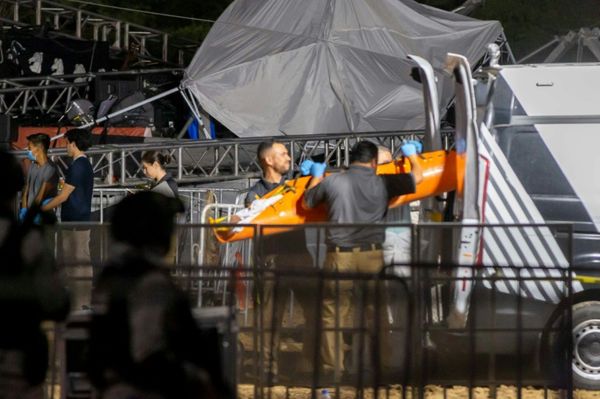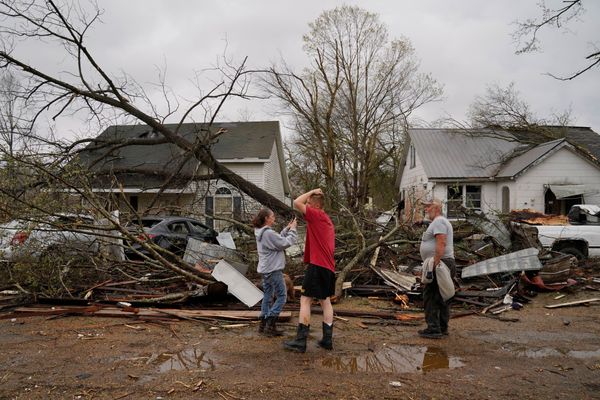
Could the first modernist architects have guessed that their utilitarian dream of houses as “machines for living” would turn into a nightmare? Maria Taniguchi’s sparse 2010 film Mies 421 draws out the surprising violence in the fabric of Ludwig Mies van der Rohe’s 1929 Barcelona Pavilion. Initially built to broadcast the progressive values of Weimar-era Germany, the building is pictured in old black-and-white slides showing its facades and uninhabited interiors. Images of hard-edged marble slabs and glass sheets flick past to the knife-sharp tick of a metronome. Stab! Slice! Sever!
Taniguchi is one of 20 contemporary artists reflecting on this architectural legacy in Horror in the Modernist Block, a new exhibition addressing the way modernist buildings themselves have become emblems of horror. It is set, fittingly, in one of the country’s most bombed and heavily redesigned cities, Birmingham.
In Britain, the idea of scary modern architecture really emerged in the postwar years, when its focus on function and efficiency was translated into rebuilt towns, new road schemes, and tower blocks. By the 1970s, vertical blocks, be they skyscrapers or council housing, had become bleak emblems of self-enclosed social breakdown, such as the dystopian luxury apartment block in JG Ballard’s High-Rise.
Yet while the show is rooted in Birmingham’s history, its curator, Melanie Pocock, has cast a global net. “There’s a trans-cultural element,” she says of the tradition linking horror with architectural modernism. “These horrors can feel very different between generations and where you are geographically in the world.” In Karim Kal’s night-time photographs of social housing on the outskirts of Paris, darkness looms beyond concrete portals, impenetrable and alien. In the Singaporean artist Ho Tzu Nyen’s magic realist film The Cloud of Unknowing, the divisions are more personal. An apartment block’s occupants impress their identities on their solitary environments to surrealist effect. They lead isolated lives in unexpected interiors – a dank watery tank, a book-stuffed cell where volumes move of their own accord – and become engulfed by actual clouds.
Modern blocks also emerged as a favoured language of authoritarian regimes. Tanaguchi’s interest in modernists such as Mies van der Rohe, for instance, began in her home country, the Philippines. Imelda Marcos, the wife of Filipino dictator Ferdinand Marcos, had a notorious “edifice complex” and spent wildly on brutalist public buildings. It’s even said that when an estimated 169 workers fell into quick-drying cement during the construction of the Manila Film Centre in 1981, remaining workers were told to prioritise finishing the building rather than recover the bodies. “It’s partly why it’s important to look at these legacies today,” says Pocock. “There’s a political amnesia. We need to remind ourselves where far-right politics has come from.”
One of the exhibition’s most chilling reminders of tragic death is a simple exit sign, positioned above the door leading out of the darkened film-screening space. Conceived by the London-based artist Abbas Zahedi, who lost an artist mentor, Khadija Saye, in the Grenfell fire, it recalls Jacob Rees-Mogg’s crass suggestion that those trapped in the building lacked common sense when they followed official advice to stay in their apartments.
The human tragedies played out in these buildings are a far cry from its early architectural vision of an unadorned, utopian international style for all. For Pocock, the problem runs deeper than the architects. She cites Chandigarh, the modernist city Le Corbusier created in the Punjab. “It’s an amazing example of civic architecture but the whole foundation of that project is based on what? Partition.”
Pocock hopes the show will help people consider where these buildings came from, be it war, political propaganda or, in the case of Grenfell’s flammable cladding, a superficial gentrification project. “Is it the building itself that’s the culprit, or what it inherits; how it’s instrumentalised and stigmatised?” she asks. “Is it doomed from the outset?”
Concrete jungle: four highlights of the exhibition
Karim Kal, Entourage 1, La Guillotière/Lyon, 2017 (main picture)
Kal’s photographs capture social housing on the outskirts of Paris at night. “On the one hand it’s totally objective,” says curator Melanie Pocock. “There’s no judgment in terms of the lives people live there. It’s what we read into those images. They’re nexus points for political neglect.”
Monika Sosnowska, Tower, 2019

The link between avant garde architecture, authoritarian politics and death emerges in twisted black steel sculptures by the Polish artist Monika Sosnowska. They reference the radio towers erected by one of Lenin’s favoured architects, Vladimir Shukhov, whose attempts to stretch material limits led to builders being killed.
Maria Taniguchi, Mies 421, 2010

Taniguchi’s film explores Ludwig Mies van der Rohe’s bastion of progressive modernist architecture, the Barcelona Pavilion, commissioned by a Weimar-era Germany that would soon descend into darkness. Pocock reflects that the artist’s “own interest in the modernist idiom does come a lot from the use of brutalism in the Philippines under the Marcos’s dictatorial regime.”
Ho Tzu Nyen, The Cloud of Unknowing, 2011

Pocock describes this film set in a Singapore housing block as “a magic realist tale. Characters are gradually encroached upon by the walls of the building and the cloud. The building is an insidious invisible layer.”
Horror in the Modernist Block is at Ikon Gallery, Birmingham, to 1 May.







